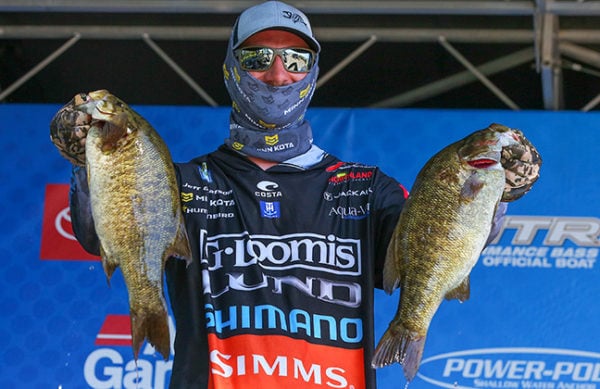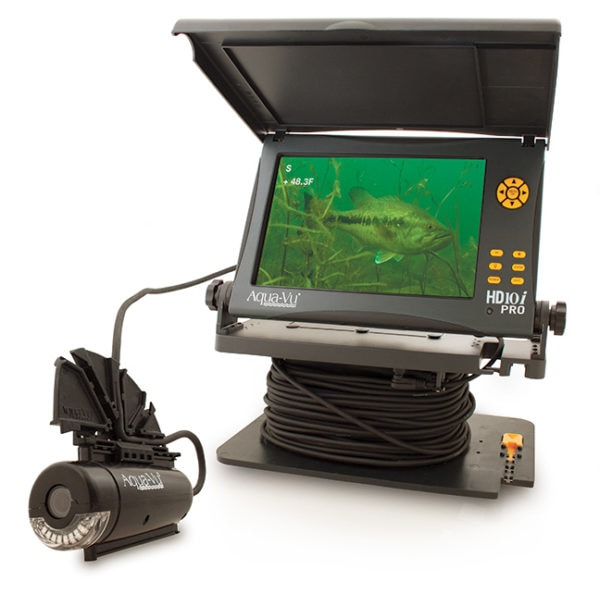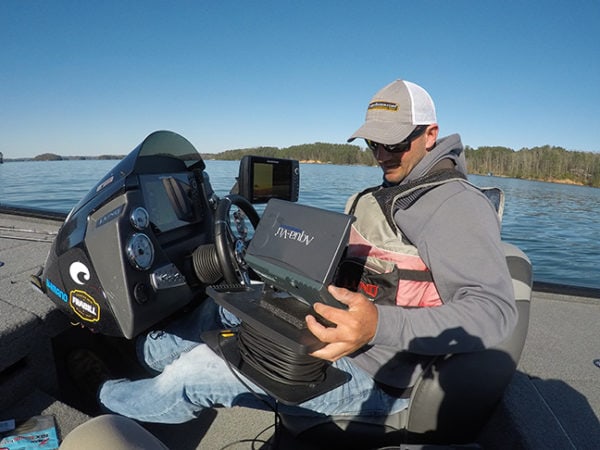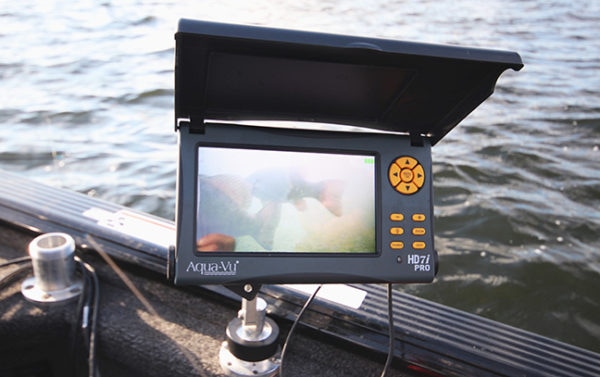Bassmaster Elite Series Anglers Talk Underwater Cameras
Category: article
Aug 13th, 2020 by Keith Worrall
Modified Aug 13th, 2020 at 2:36 PM
Bassmaster Elite Series Anglers Talk Underwater Cameras
“A lot of anglers still mistakenly believe underwater cameras are only for ice fishing,” says Bassmaster Elite Series angler Jeff “Gussy” Gustafson. “But if you don’t have a camera in your bass boat, you’re definitely missing out on big bass in a lot of waterbodies.”
Crosslake, MN (August 12, 2020) – This past month, as the Bassmaster Elite Series, FLW and MLF / Bass Pro Tours have shifted to northern U.S. and Great Lakes venues, successful patterns have revolved around offshore structure, clear water and smallmouth bass that heft like sacks of sugar.
At the late July Elite Series event at the St. Lawrence River, eventual champion Chris Johnston spied on smallmouth bass through the lens of an Aqua-Vu HD7i Pro, borrowed from his buddy and fellow Canadian angler Jeff Gustafson. “I’ve used an Aqua-Vu for probably the past ten years,” noted Johnston, who earned his first Elite Series win, following years of near-misses, and the first ever for a Canadian angler. “To confirm fish species, size and their position without putting hooks into them in prefishing, a camera is invaluable.”

Gussy credits his underwater camera and Z-Man soft plastics for back-to-back Top-20 Bassmaster Elite Series finishes.
To earn his St. Lawrence win, Johnston keyed on several rockpiles in 20 to 50 feet of water along a 500-yard stretch of river. He noted that certain areas held big 5-pound bass, while plenty of other areas contained drum or walleye—easy to identify on camera, but much more difficult if not impossible to discern with sonar.
“An Aqua-Vu is a huge player on that river system and people are just starting to realize its value and the power of what it can show you,” added Johnston.
Earning a respectable 12-place finish, Jeff “Gussy” Gustafson credited his console-mounted Aqua-Vu for finding big bass hiding amid vast stretches of river. “The camera is such an efficient search tool in big rivers because you drop the optics below your boat and just do long drifts,” observed Gussy. “As you drift, the camera’s 90-degree optics reveal a wide swath of water in front of the lens. A special stabilizing fin keeps the camera facing whatever direction your boat is travelling. It’s a pleasure to work with in the current, allowing you to canvass a ton of water, dropping (GPS) digits on all the little sweet spots, such as each big boulder holding a 5 pounder.”
Gussy noted that while many river areas contained boulders that were easy to spot on side imaging, the bass themselves had a knack for hiding from the sonar beam. “In a lot of these current situations, smallmouths tuck right in close to bottom and you can’t see them on sonar. But they can’t hide from the camera lens. And you get to see how each fish relates to different rock and sand spots, which gives you little clues about how to catch them.

“The key in the tournament was to find which boulders held the 5 pounders. Seemed like the spot either held a few big ones, or it had ten smaller bass but no bigs. Also, lots of spots held drum, which look almost identical to a bass on sonar, but stick out like a sore thumb on the camera screen.”
Interestingly, while first-time underwater viewers adopt the mistaken notion that the optics spook fish, smallmouth bass almost always display the opposite behavior, swimming over to investigate the lens out of curiosity.
“Yeah, it’s pretty funny to watch bass and their reaction to the lens,” says Gussy. “They’ll swim right up to the camera, try to bully it like it’s a living thing. We see some pretty interesting stuff with the Aqua-Vu, including bass with jigs still in their jaws. We’ve also seen plenty of old boats, sitting half-buried on the bottom, encrusted with mussels. Some areas are absolutely filthy with gobies—you see dozens of them flying around, fleeing. For whatever reason, we’ve learned that these heavy goby areas rarely offer good fishing for smallmouth bass. Here, the camera helps us eliminate even more unproductive water—and gobies don’t show up on sonar, either.”

Bassmaster Elite Series angler Chris Johnston has relied on an Aqua-Vu underwater camera for the past ten years. (Photo by B.A.S.S. / Seigo Saito)
A week after the St. Lawrence event, Gussy lent his underwater cam to fellow pro Carl Jacumsen at Lake Champlain. “Gussy showed me just how powerful the Aqua-Vu can be,” noted the native Australian bass pro. “At Champlain, I learned more in one day using the camera than I could have in a year with other search tools.”
Notching his second-consecutive top 20-finish, Gussy spied big deepwater smallmouths at Champlain hovering near select boulders. “I learned a lot of the big boulders held two to eight smallmouths on them. In practice, I figured out that I could mark a boulder on side imaging and then circle back and drop the camera to check for bass presence and size, and not burn them with a hook in the jaw. If the boulder held bass, I’d lay down a waypoint and return during the tourney. If it was some other species, I could immediately cross it off the list. Eventually, I learned that drum, for example, were hovering a little higher off bottom than the bass, which proved to be another key detail that could’ve easily been overlooked had I not had the Aqua-Vu on board.”

Jeff “Gussy” Gustafson says an Aqua-Vu unlocks the underwater secrets of the country’s top bass fisheries.
To weigh nearly 55 pounds of Lake Champlain smallmouths, Gussy deployed a dropshot rigged 5-inch Z-Man Jerk ShadZ in 28 to 35 feet of water. As an interesting side note, eventual tournament champ Brandon Palaniuk observed several competitors using the camera and became intrigued by its potential.
“In the past, we weren’t allowed to use underwater cameras in tourneys,” noted Palaniuk. “But after the last couple events and listening to Gussy and Carl (Jacumsen) talk about the things they see on the camera screen, I realize it’s time to start using one. Just gaining a better understanding of exactly what I’m seeing on sonar and learning how to interpret the underwater terrain is super exciting. I’m excited to try the Aqua-Vu at St. Clair.”
“Safe to say, a majority of the top 20 anglers at these events—especially on the St. Lawrence—used cameras,” adds Gustafson. “Certainly, a lot of us will be dropping the lens as we roll into the Lake St. Clair Elite event.
“Yeah, an Aqua-Vu is a cool ice fishing tool. But I think a lot of anglers are realizing it’s just as powerful for breaking down water while sitting in a bass boat.”

Until recently, use of an underwater camera has remained a well-guarded secret among elite bass anglers.
